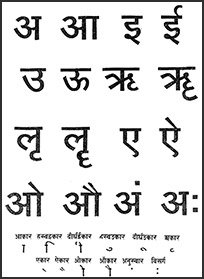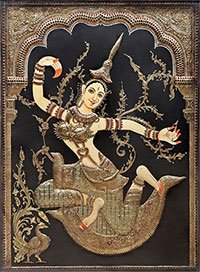Karshana, Karśaṇa, Karśana: 16 definitions
Introduction:
Karshana means something in Hinduism, Sanskrit, Marathi, Hindi, biology. If you want to know the exact meaning, history, etymology or English translation of this term then check out the descriptions on this page. Add your comment or reference to a book if you want to contribute to this summary article.
The Sanskrit terms Karśaṇa and Karśana can be transliterated into English as Karsana or Karshana, using the IAST transliteration scheme (?).
Alternative spellings of this word include Karshan.
In Hinduism
Vyakarana (Sanskrit grammar)
Source: Wikisource: A dictionary of Sanskrit grammarKarṣaṇa (कर्षण).—Extension; protraction, defined as kālaviprakarṣa by commentators; a peculiarity in the recital as noticed in the pronunciation of ट् (ṭ) when followed by च् (c), or ड् (ḍ) when followed by ज् (j) e.g. षट्चै (ṣaṭcai); षड्जात (ṣaḍjāta). cf. Nār. Śik. I.7.19.

Vyakarana (व्याकरण, vyākaraṇa) refers to Sanskrit grammar and represents one of the six additional sciences (vedanga) to be studied along with the Vedas. Vyakarana concerns itself with the rules of Sanskrit grammar and linguistic analysis in order to establish the correct context of words and sentences.
Sports, Arts and Entertainment (wordly enjoyments)
Source: archive.org: Syainika Sastra of Rudradeva with English Translation (art)1) Karṣaṇa (कर्षण) refers to “drawing (the hawk) nearer” (during its training), according to the Śyainika-śāstra: a Sanskrit treatise dealing with the divisions and benefits of Hunting and Hawking, written by Rājā Rudradeva (or Candradeva) in possibly the 13th century.—Accordingly, [while discussing the training of hawks]: “[...] The next step is to cast it into a tree and then lure it. At this time, in order to recall to its mind its wild habits, it should be allowed to prey upon pigeons and Kalaviṅkas. Those who cannot be tamed in this way should be carefully subjugated to the will of their master, by much ‘watching,’ by continually stroking them with the hand, and by drawing them nearer and nearer (karṣaṇa). [...]”.
2) Karṣaṇa (कर्षण) refers to “bring someone under subjugation (by diplomacy)”, according to the Śyainika-śāstra.—Accordingly, [while discussing the importance of hawks]: “To restore peace to a conquered country, to deliberate on conquering others, to bring the wicked under subjugation (karṣaṇa) by diplomacy [duṣṭānāṃ karṣaṇaṃ yuktyā], to protect the loyal, to encourage those who have done great deeds by fulfilling their aspirations, [...] and such other qualities, which have been highly spoken of in politics [are considered also essential in the art of hawking]”.

This section covers the skills and profiencies of the Kalas (“performing arts”) and Shastras (“sciences”) involving ancient Indian traditions of sports, games, arts, entertainment, love-making and other means of wordly enjoyments. Traditionally these topics were dealt with in Sanskrit treatises explaing the philosophy and the justification of enjoying the pleasures of the senses.
Shaivism (Shaiva philosophy)
Source: eScholarship: The descent of scripture: a history of the KamikagamaKarṣaṇa (कर्षण) refers to the “ploughing (of the earth)” (that is to precede construction), according to the Kāmikāgama: an ancient Śaiva Āgama scripture in 12,000 Sanskrit verses dating to at least the 5th century and represented as an encyclopedic account of ritual instructions (kriyāpāda).—In modern print editions, the Kāmika-āgama is structured in two major parts. The Pūrvabhāga consists of 75 chapters (paṭalas) [...] Chapters 9 to 34 present a general account of the principles and preliminary rites for the construction of temples, houses, buildings, and settlements. [...] Chapter 11 outlines criteria for evaluating a construction site. In Chapters 12 and 13, there are descriptions of offerings to be made at the entrance to the site and a procedure for taking possession of the site. Chapter 14 provides directions for the ploughing of the earth that is to precede construction (bhū-karṣaṇa).

Shaiva (शैव, śaiva) or Shaivism (śaivism) represents a tradition of Hinduism worshiping Shiva as the supreme being. Closely related to Shaktism, Shaiva literature includes a range of scriptures, including Tantras, while the root of this tradition may be traced back to the ancient Vedas.
Biology (plants and animals)
Source: Google Books: CRC World Dictionary (Regional names)Karsana in India is the name of a plant defined with Pisum sativum in various botanical sources. This page contains potential references in Ayurveda, modern medicine, and other folk traditions or local practices It has the synonym Lathyrus oleraceus Lam. (among others).
Example references for further research on medicinal uses or toxicity (see latin names for full list):
· Journal of Wuhan Botanical Research (1998)
· Plant Systematics and Evolution (1995)
· Journal of the Indian Botanical Society (1986)
· Bulletin of the Hiroshima Agricultural College (1989)
· Protoplasma (1979)
· Plant Systematics and Evolution (1988)
If you are looking for specific details regarding Karsana, for example health benefits, chemical composition, diet and recipes, side effects, extract dosage, pregnancy safety, have a look at these references.

This sections includes definitions from the five kingdoms of living things: Animals, Plants, Fungi, Protists and Monera. It will include both the official binomial nomenclature (scientific names usually in Latin) as well as regional spellings and variants.
Languages of India and abroad
Marathi-English dictionary
Source: DDSA: The Molesworth Marathi and English Dictionarykarśaṇa (कर्शण).—n S A division or branch of medicine,--that which treats of Reducing or lowering: opp. to bṛṃhaṇa Nourishing or fattening.
--- OR ---
karṣaṇa (कर्षण).—n S Ploughing or tilling. 2 Pulling or drawing.
Marathi is an Indo-European language having over 70 million native speakers people in (predominantly) Maharashtra India. Marathi, like many other Indo-Aryan languages, evolved from early forms of Prakrit, which itself is a subset of Sanskrit, one of the most ancient languages of the world.
Sanskrit dictionary
Source: DDSA: The practical Sanskrit-English dictionaryKarśana (कर्शन).—a.
1) Rendering lean.
2) troubling, hurting; यदाश्रौषमसुराणां वधार्थे किरीटिनं यान्तममित्रकर्शनम (yadāśrauṣamasurāṇāṃ vadhārthe kirīṭinaṃ yāntamamitrakarśanama) Mahābhārata (Bombay) 1.1.165.
-naḥ Fire.
--- OR ---
Karṣaṇa (कर्षण).—a.
1) Dragging.
2) Injuring
3) Extending (in time), see below.
-ṇam [kṛṣ bhāve lyuṭ]
1) Drawing, dragging, pulling, bending (as of a bow); भज्यमानमति- मात्रकर्षणात् (bhajyamānamati- mātrakarṣaṇāt) R.11.46,7.62.
2) Attracting.
3) Ploughing, tilling; प्रभृतं कर्षणं स्मृतम् (prabhṛtaṃ karṣaṇaṃ smṛtam) Manusmṛti 4.5.
4) Injuring, tormenting; emaciation; तथा राज्ञामपि प्राणाः क्षीयन्ते राष्ट्र- कर्षणात् (tathā rājñāmapi prāṇāḥ kṣīyante rāṣṭra- karṣaṇāt) Manusmṛti 7.112.
5) Cultivated land; पुत्रस्य ते पशवः कर्षणं च (putrasya te paśavaḥ karṣaṇaṃ ca) Mahābhārata (Bombay) 3.113.13.
6) A weapon; इषुभिस्तोमरैः प्रासै- स्त्रिशूलैर्वज्रकर्षणैः (iṣubhistomaraiḥ prāsai- striśūlairvajrakarṣaṇaiḥ) Rām.7.32.34.
Source: Cologne Digital Sanskrit Dictionaries: Shabda-Sagara Sanskrit-English DictionaryKarṣaṇa (कर्षण).—n.
(-ṇaṃ) 1. Ploughing, cultivating the ground. 2. Pulling, dragging. 3. Attracting. E. kṛṣ to plough, lyuṭ aff.
Source: Cologne Digital Sanskrit Dictionaries: Benfey Sanskrit-English DictionaryKarśana (कर्शन).—i. e. kṛś + ana, I. adj. Causing to grow lean, [Suśruta] 1, 189, 1. Ii. m. Fire, Mahābhārata 13, 6307.
--- OR ---
Karṣaṇa (कर्षण).—i. e. kṛṣ + ana, n. 1. Bringing, [Śākuntala, (ed. Böhtlingk.)] 69, 15, v. r. 2. Tormenting, [Mānavadharmaśāstra] 7, 112. 3. Bending (a bow), [Raghuvaṃśa, (ed. Stenzler.)] 11, 46. 4. Tillage, [Mānavadharmaśāstra] 4, 5. 5. Cultivated land, Mahābhārata 3, 10082. 6. At the end of a compound adj. Overpowering, e. g. śatru-, Overpowering his enemies, [Rāmāyaṇa] 4, 38, 51.
Source: Cologne Digital Sanskrit Dictionaries: Cappeller Sanskrit-English DictionaryKarśana (कर्शन).—[adjective] rendering lean, attenuating; tormenting, vexing (—°).
--- OR ---
Karṣaṇa (कर्षण).—[adjective] tearing, vexing (—°); [neuter] tearing, drawing near or away; bending (of a bow), vexing, tormenting; ploughing, agriculture.
Source: Cologne Digital Sanskrit Dictionaries: Monier-Williams Sanskrit-English Dictionary1) Karśana (कर्शन):—mfn. (√kṛś), rendering lean, attenuating, causing emaciation, [Suśruta]
2) troubling, hurting, [Mahābhārata xiii, 6307] (cf. karṣaṇa)
3) n. the act of rendering lean, causing emaciation, [Caraka]
4) Karṣaṇa (कर्षण):—[from karṣa] mfn. pulling to and fro, dragging, tormenting, vexing ([varia lectio] karśana), [Mahābhārata; Rāmāyaṇa] etc.
5) [v.s. ...] extending (in time), [Atharvaveda-prātiśākhya]
6) [v.s. ...] the act of drawing or dragging near, [Śakuntalā] ([varia lectio])
7) [v.s. ...] drawing out, pulling off
8) [v.s. ...] tugging, pulling (cf. keśa-k), drawing to and fro, removing, hurting, injuring, tormenting, [Manu-smṛti vii, 112; Mahābhārata; Suśruta] etc.
9) [v.s. ...] drawing back, bending (a bow), [Raghuvaṃśa xi, 46] (cf. dhanuṣ-k)
10) [v.s. ...] prolonging (a sound), [Saṃhitā-upaniṣad-brāhmaṇa]
11) [v.s. ...] ploughing, cultivating the ground, [Manu-smṛti iv, 5; Mahābhārata; Bhāgavata-purāṇa]
12) [v.s. ...] cultivated land, [Mahābhārata iii, 10082]
13) [v.s. ...] erroneous for karśana q.v., [Caraka]
14) Kārśana (कार्शन):—mfn. ([from] kṛśana), consisting of pearl or mother-of-pearl, [Atharva-veda iv, 10, 7][Mss. karśana.]
Source: Cologne Digital Sanskrit Dictionaries: Yates Sanskrit-English DictionaryKarṣaṇa (कर्षण):—(ṇaṃ) 1. n. Ploughing; pulling.
Source: DDSA: Paia-sadda-mahannavo; a comprehensive Prakrit Hindi dictionary (S)Karṣaṇa (कर्षण) in the Sanskrit language is related to the Prakrit words: Aṃchaṇa, Kaṭṭhaṇa, Kaḍḍhaṇa, Karisaṇa, Kheḍaṇa.
[Sanskrit to German]
Sanskrit, also spelled संस्कृतम् (saṃskṛtam), is an ancient language of India commonly seen as the grandmother of the Indo-European language family (even English!). Closely allied with Prakrit and Pali, Sanskrit is more exhaustive in both grammar and terms and has the most extensive collection of literature in the world, greatly surpassing its sister-languages Greek and Latin.
Hindi dictionary
Source: DDSA: A practical Hindi-English dictionaryKarṣaṇa (कर्षण) [Also spelled karshan]:—(nm) traction; extraction.
...
Kannada-English dictionary
Source: Alar: Kannada-English corpusKarṣaṇa (ಕರ್ಷಣ):—
1) [adjective] drawing; pulling; attracting towards.
2) [adjective] troubling; harrassing; annoying.
--- OR ---
Karṣaṇa (ಕರ್ಷಣ):—
1) [noun] the act or an instance of attracting, pulling, drawing.
2) [noun] the act of bending (a bow).
3) [noun] the act of ploughing.
4) [noun] the act or an instance of troubling; harrassing; annoying.
Kannada is a Dravidian language (as opposed to the Indo-European language family) mainly spoken in the southwestern region of India.
See also (Relevant definitions)
Starts with: Karshanata, Karshanava.
Ends with (+45): Abhikarshana, Abhyavakarshana, Adhikarshana, Akamakarshana, Akarshana, Amitrakarshana, Anakarshana, Andakarshana, Anukarshana, Apakarshana, Arikarshana, Atikarshana, Atmotkarshana, Attakarshana, Avakarshana, Balapakarshana, Bhaga-karshana, Bhukarshana, Cittakarshana, Dantakarshana.
Full-text (+53): Atikarshana, Akamakarshana, Dantakarshana, Sharirakarshana, Khedana, Gatrakarshana, Avakarshana, Shatrukarshana, Kalindikarshana, Nikarshana, Malakarshana, Anukarshana, Arikarshana, Rashtrakarshana, Akarshana, Apakarshana, Vikarshana, Kamakarshana, Samkarshanasutravicara, Samkarshanamaya.
Relevant text
Search found 18 books and stories containing Karshana, Karśaṇa, Karsana, Karṣaṇa, Karśana, Kārśana; (plurals include: Karshanas, Karśaṇas, Karsanas, Karṣaṇas, Karśanas, Kārśanas). You can also click to the full overview containing English textual excerpts. Below are direct links for the most relevant articles:
Garga Samhita (English) (by Danavir Goswami)
Verse 6.18.39 < [Chapter 18 - In the Course of Describing the Glories of Siddhāśrama, a Description of the Rāsa-dance Festival]
Verse 1.6.37 < [Chapter 6 - Description of Kaṃsa’s Strength]
Rig Veda (translation and commentary) (by H. H. Wilson)
Rig Veda 1.53.2 < [Sukta 53]
Bhakti-rasamrta-sindhu (by Śrīla Rūpa Gosvāmī)
Verse 3.3.92 < [Part 3 - Fraternal Devotion (sakhya-rasa)]
Nitiprakasika (Critical Analysis) (by S. Anusha)
Hiranyakesi-grihya-sutra (by Hermann Oldenberg)
Atharvaveda and Charaka Samhita (by Laxmi Maji)
Ulcers (vraṇa) according to Caraka < [Chapter 4 - Diseases and Remedial measures (described in Caraka-saṃhitā)]
2a. Tuberculosis (Yakṣmā or Rājayakṣmā) in the Atharvaveda < [Chapter 5 - Diseases and Remedies in Atharvaveda and Caraka-Saṃhitā]